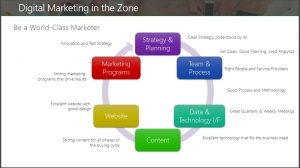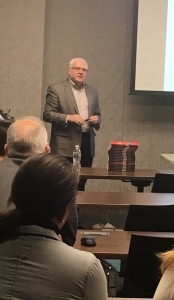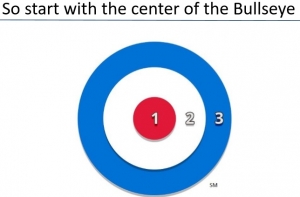On October 17th, AMA Boston had the great pleasure of presenting two leading business strategists at the Microsoft Technology Center in Burlington, MA. David Reske and Louis Gudema shared their vast knowledge about a core element of successful organizations is often overlooked in the current wave of new technologies and fads – strategy. Here are the key take-aways from their presentations:
 David Reske, Founder and President, Nowspeed
David Reske, Founder and President, Nowspeed
- Being in the Zone is the goal, beyond digital marketing, helping those who achieve it to be focused, calm, and positive; they also experience time slowing down, not worrying about others, and feeling secure and confident.
- The revolution in digital technology has changed buyer behavior, creating buyers who are more educated, social, tech savvy, mobile, global and open to more alternatives!
- Today’s digital leaders, e.g. Amazon, Facebook, Google, Apple, Uber have created a different buying experience: fast, easy, visual, content-driven, and social. The companies have reaped huge rewards, with Amazon’s market value skyrocketing while those of most traditional retailers, except Wal-Mart, have seen theirs sharp drops.
- Example: in auto buying, 4 in 5 people now use the Internet for car buying, visiting 10 auto websites while almost half visit only one dealer before buying.
David then offered some enlightening “past and today” examples of how these changes are affecting markets – one major effect is that customers are confused!
- Past: Buyers learned about products by spending time with salespeople, reading brochures and white
 papers. Today: Buyers learn from websites and video and want a complete, self service experience
papers. Today: Buyers learn from websites and video and want a complete, self service experience - Past: Buyers learned from their peers at trade shows. Today: Buyers are spending hours per day on social media
- Past: Direct mail and print advertising drove leads. Today: Direct mail and print ads no longer work, and on the web, ads are 100% of the page above the “fold” on search engines
- A Digital Marketing Checkup (www.marketing-in-the-zone.com) helps you learn whether you’re you in the Zone via questions about your marketing, strategy and goals, then assesses potential gaps with the Zone Checkup Gap Analysis, and Situation Analysis. As with any strategic undertaking, it’s crucial to identify your goals, success metrics, customer, and key messages.
- David then conveyed key elements of the buyer’s journey: using awareness, evaluation and purchase information to make decisions; and creating personas through the use of objectives, characteristics, and obstacles.
- He also provided valuable insights of important support functions for marketing, with the goal of developing a Level-5 team, including budgeting and planning, performing a team assessment to get the right person in the right seat, assessing service provider report cards and gap analyses, and managing team meetings and program management tools to keep the team organized.
- Next was a very informative marketing technology grid that displayed the companies providing key services
 in the areas of advertising, content and experience, social and relationships, commerce, data, and management.
in the areas of advertising, content and experience, social and relationships, commerce, data, and management.
- David also presented a marketing technology on advertising specifically, with headers covering category,
 subcategory, product requirements, fit, value, innovation, usability, and cost.
subcategory, product requirements, fit, value, innovation, usability, and cost. - Scorecards, lead funnels, content assessments, marketing automation, web development, SEO and more were also explained, before David wrapped up with a powerful summary of the big picture – Digital Marketing in the Zone!
 Louis Gudema, Founder and President, revenue + associates
Louis Gudema, Founder and President, revenue + associates
Who says your marketing can’t be better, faster and cheaper?
- Louis started with the tale of three clients: one where the CEO doesn’t want to speak with unhappy clients, a software company that takes two weeks to get leads from marketing to sales, and a multi-billion dollar company that uses left-over money for its search ads at the end of each quarter.
- He then posited “The Challenge,” showing a Marketing Technology Landscape that covers the Martech 5000 in Advertising and Promotion, Content and Experience, Social and Relationships, Commerce and Sales, Data and
 Management, each category with dozens more sub-categories and leading providers of the services. Challenging, indeed, for most any company to capitalize on such a robust and complex market.
Management, each category with dozens more sub-categories and leading providers of the services. Challenging, indeed, for most any company to capitalize on such a robust and complex market.
 The solution? Louis introduced his Bullseye Marketing Framework.
The solution? Louis introduced his Bullseye Marketing Framework.
- In the inner circle, take full advantage of your marketing assets via the web, email, retargeting and sales-marketing alignment.
- In the second circle, connect with people in-market now through search and intent data.
- In the third circle, build long-term awareness and brand using social, advertising, and inbound marketing tools.
-
Disadvantages and Advantages of the Third Circle
- The third circle is hampered by several factors, shown by Hubpsot’s acquisition rising over 250% in 5 years; Facebook organic reach down by almost 50% since 2013; just .5% of display ads elicit engagement; and sharp declines in organic social media reach and engagement (did you know the typical organic social media post is now seen by 2-3% of followers, with engagement of <.1% of followers?).
- BUT – there are critical advantages too: companies with strong brands keep customers longer, can charge more and acquire them less expensively. Content can be an evergreen asset.
-
Second Circle Disadvantages and Advantages
- Challenges: SEO is slow: just 5% of new content gets ranked on page one within 1 year; it’s expensive – with competition, costs per click keep going up.
- BUT – the second circle is based on valuable intent data such as demographics, psychographics and visitor activity on your website from people in-market.
-
The Center Has Many Advantages – Start There
 Talk with and sell to current customers; have listening conversations
Talk with and sell to current customers; have listening conversations- Selling to current customers makes sense compared with 5 to 25 greater cost to acquire a new customer than to grow an existing one
- Create customer advocates, as increasing your customer retention rate by 5% increases profits by 25% to 95%, per a Bain and HBS Study
- Email marketing is your 800 pound gorilla; McKinsey shows it as 40X more effective for lead gen than social media. Louis then added several valuable lessons on the frequency of emailing, and the power of conversion optimization through A/B testing.
- Competitors can’t easily undermine first circle assets
- Other key factors in the inner circle include website conversion optimization and landing page optimization
-
Disadvantages of the First Circle
- You can only optimize and increase current customer sales so much. Eventually you’ll need new customers.
-
What Should You Do?
- With all these factors, what is a company’s best course of action? Louis wrapped up with this direction:
-
Ultimately, do it all. Go Cross-Channel.
AMA Boston would like to thank David, Louis and the great audience for an entertaining and thought-provoking workshop, and we look forward to seeing you at one of our next events!


